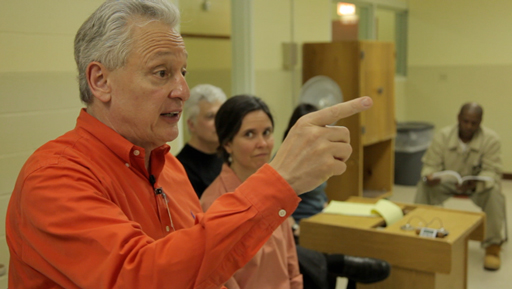3.1 Experiencing meditation in prison
This is an excerpt from an interview with Fleet Maull (2005), who you read about in ‘Mindfulness’. Here he talks about his journey from being sentenced to 30 years in prison, to applying the meditation practices he’d previously learned in order to get through the experience, and eventually founding the Prison Dharma Network.
Transcript: Fleet Maull: waking up in prison
Activity 3 How can meditation practice help prisoners?
Having heard the excerpt from Fleet Maull’s interview, use the box below to make a list of ways in which meditation or mindfulness practice can be helpful to people in prison.
Also, jot down any criticisms you have of the focus on mindfulness and/or meditation practices in prison.
Discussion
From Maull’s interview you might have noticed the following things that he, and other prisoners, got out of their meditation practice:
- something to fill, or structure, their time in prison
- a sense of meaning or purpose: something worthwhile to do with the time, making sure something good comes from a bad situation
- an air of being dedicated and disciplined, which elicits respect from other prisoners and staff
- an ethical code to follow, around being of service to others, with role models in the form of teachers or facilitators
- an antidote to the guilt or shame they feel about the crimes they committed
- a sense of belonging with the other prisoners who are part of the meditation, mindfulness or Dharma group
- a place to talk openly and honestly about their struggles, and to receive support.
Reflecting more critically about the use of mindfulness or meditation programmes in prison, you might have considered the following points about their shortcomings:
- Adding mindfulness or meditation programmes into the existing criminal justice system doesn’t address some of the serious problems with this system, such as class and race injustices around who is incarcerated .
- It does little to address the questions over whether imprisonment is effective at rehabilitating people, and whether it is appropriate treatment for people who are, themselves, often the victims of serious abuse. If one of the key aims of mindfulness is cultivating kindness and compassion, what are the implications of trying to do this within a system which is, itself, often cruel? For example, Maull’s interview highlights that there is a high risk of further physical or sexual abuse in the prison system, and that staff often treat prisoners as inferior human beings.
- Many people in prisons may already have existing spiritual practices, faiths and beliefs. Should mindfulness be offered as an alternative to these, or would it be more appropriate to explore what is available in each group’s or individual’s own cultural background, encouraging them to develop that?
These points relate to some of the wider criticisms of the mindfulness movement, which we will explore shortly. Critics have argued that it is problematic to bring mindfulness practices into settings such as workplaces, schools and prisons as a kind of add-on, without challenging the often unethical ways in which these settings operate. For example, people are frequently unequally valued within hierarchical structures, often bullied or otherwise abused, and treated as objects to produce outcomes and reach targets rather than as full human beings.
Critics have also pointed to the cultural issues with this westernised, secularised version of Buddhism being offered to everyone regardless of the rich spiritual traditions and practices they may already be engaged with – many of which include similar ideas to mindfulness.

